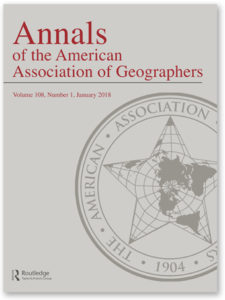All Woman Panel on Climate Organized for SEDAAG Fall Regional Meeting
 Dr. Jennifer Collins and Dr. Kathy Sherman-Morris organized an all female panel of Climate Specialty Group (CSG) members at SEDAAG to discuss the 2017 hurricane season. Panel members included: Dr. Jennifer Collins (USF), Dr. Kelsey Ellis (UTK), Dr. Corene Matyas (UF), Dr. Stephanie Zick (Virginia Tech), and the panel was moderated by Dr. Kathy Sherman-Morris (Mississippi State University) (from left to right in photo at left).
Dr. Jennifer Collins and Dr. Kathy Sherman-Morris organized an all female panel of Climate Specialty Group (CSG) members at SEDAAG to discuss the 2017 hurricane season. Panel members included: Dr. Jennifer Collins (USF), Dr. Kelsey Ellis (UTK), Dr. Corene Matyas (UF), Dr. Stephanie Zick (Virginia Tech), and the panel was moderated by Dr. Kathy Sherman-Morris (Mississippi State University) (from left to right in photo at left).
Dr. Kathy Sherman-Morris asked questions about the 2017 hurricane season from “Is what we saw in 2017 an indication of a new normal?” to “What prominent issues were there with communication or response?” Dr. Jennifer Collins started the panel discussion off with an overview of the 2017 Atlantic hurricane season, noting that it was a year of new records: no single storm in the U.S. in recorded history has unleashed such a large volume of rainfall as Harvey did. Harvey was also the first major hurricane to make landfall since Hurricane Wilma in 2005. Irma was the strongest storm on record outside of the Caribbean and Gulf with 185 mph lifetime maximum winds, with multiple landfalls as a Category 5 in the Caribbean islands and Cuba, and was the longest storm as a Category 5 in the Atlantic Ocean in the satellite area. Maria made landfall as a Category 5 in the Caribbean, and is the 2nd strongest hurricane to strike Puerto Rico, second to the 1928 Lake Okeechobee Hurricane.
These storms presented opportunities to consider lessons learned, understand evacuation behavior and risk perception, discuss inland flooding, consider relationship to climate change, and provide new and exciting research opportunities and teachable moments. In responding to a question about the factors that contributed to the 2017 season’s tropical activity, panel members noted that the large-scale conditions were quite conducive for hurricane activity – very warm sea-surface temperatures, weak vertical wind shear and high mid-level moisture throughout the month of September in particular. Vertical wind shear was especially low in the central tropical Atlantic and the eastern Caribbean, the region where Irma, Jose and Maria all reached their maximum intensity.
When asked if the panel members have incorporated the 2017 season into their research, Collins replied that she was working with students and other collaborators on some projects including 1) an analysis of the 2017 hurricane season that considers records of the season’s tropical cyclone statistics, as well as an examination of the environmental factors conducive for the hurricane activity present in the 2017 season and 2) consideration of the role of geophysical factors, as well as people’s social connections, which affected people’s evacuation decision for Hurricane Irma. Collins also mentioned the upcoming (2018) Research Experience for Undergraduates (REU) program, aimed at rising sophomores. The REU program will allow students to gain a mentored research experience integrating the physical and social sciences. Some REU projects will take advantage of data collected during Irma, and other projects will allow more data to be gathered relating to the evacuations, and preparedness since Hurricane Irma. Zick described a few research ideas that were motivated by the landfall of Hurricane Harvey, including 1) a modeling study of landfall and spin down in a barotropic environment and 2) a precipitation verification study to elucidate the performance of high resolution models such as the High Resolution Rapid Refresh (HRRR) model. Regarding her research, Matyas noted that she is examining the spatial configuration of the rainbands of Harvey and Irma using ground-based radar data and contrasting their development based on moisture in the surrounding environment. Sharp gradients in moisture tend to co-locate with rainbands on the leading edges of the TCs, while moisture sourced from the deep tropics facilitates high rain rates until air with lower moisture content advects around the south side of the circulation center.
Similarly, when the audience inquired if panel members have incorporated the 2017 into their teaching, the panel explained how the season provided ample opportunity for the students to present and discuss thermodynamic and dynamic conditions associated with tropical cyclone formation and lifecycle, as well as the seasonal environmental conditions present. Students also reflected on how the storms affected their area such as the preparations and evacuation decisions people were making. Ellis reviewed how the active hurricane season garnered student attention in her general education Weather, Climate, and Climate Change course, and that the 2017 season provided a foundation for observing the differences between weather and climate, and cycles and trends. It also provided an opportunity to examine current understanding of the hurricane-climate connection, and challenges with discerning the effects of climate change. The panel members presented these topics as the hurricane season was officially coming to an end.
Written by Jennifer Collins with contributions from Kelsey Ellis, Corene Matyas, and Stephanie Zick.


